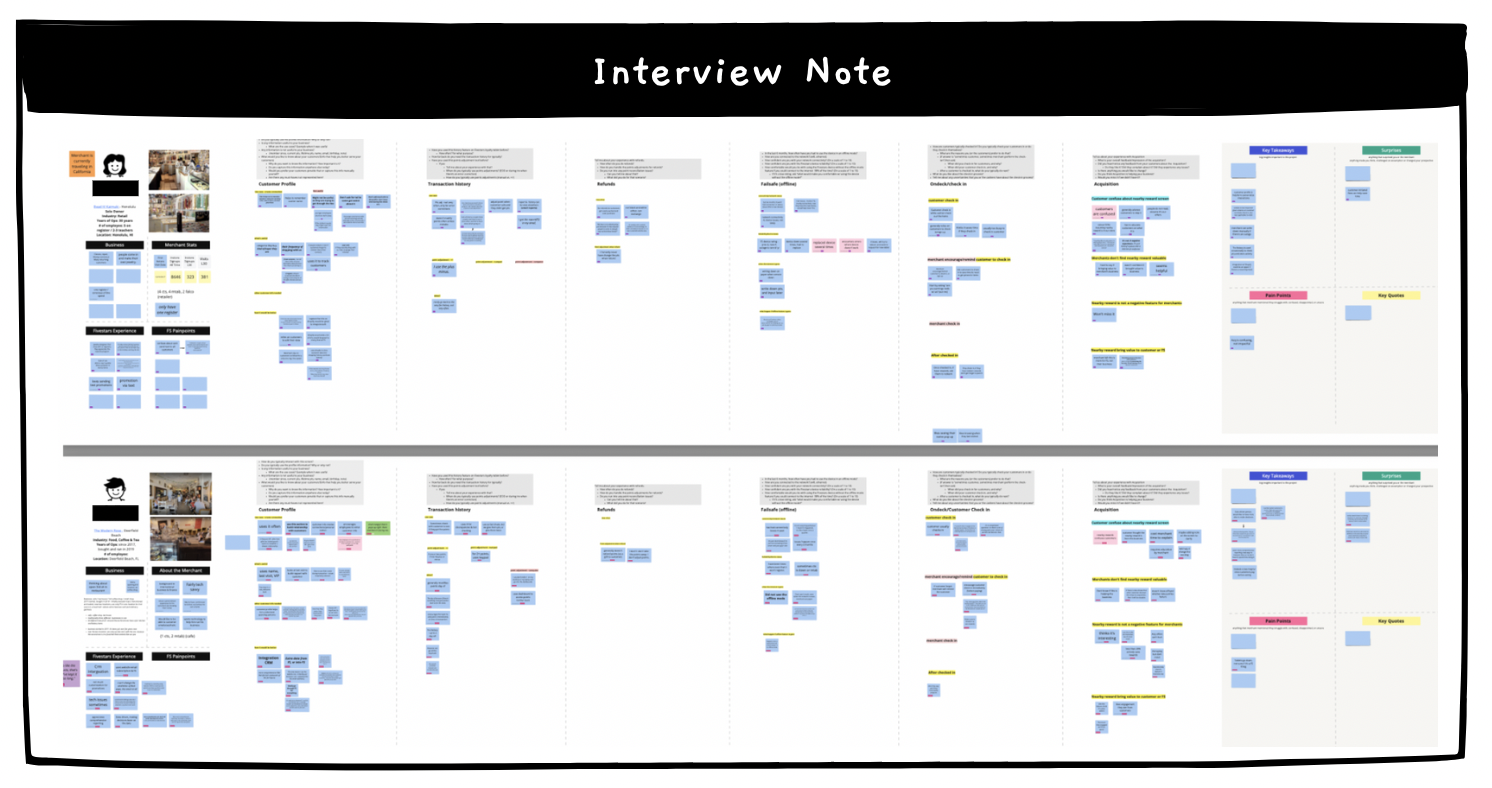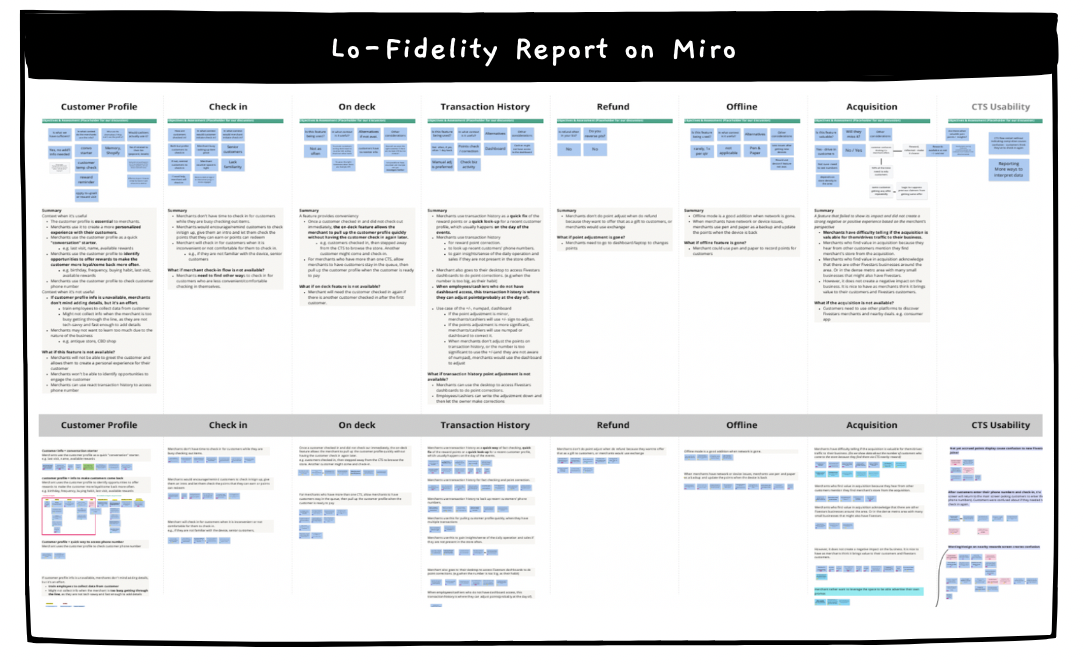Feature Priority Discovery Research
Uncover User Preferences to Shape Product Roadmaps and Enhance User Satisfaction




The in-store product team plans to migrate a legacy merchant and customer-facing product (touchscreen device) to an updated web codebase. This update will unlock new features that can generate more business opportunities.
Challenge
The migration will significantly alter current features and user flows. The team is concerned that these changes could result in dissatisfied users and potential churn.
How might we execute a seamless migration with minimal disruption and deliver an improved user experience that caters to the users’ needs?
Solution
We outlined three research projects to achieve this goal. This page focuses on the 1st project, we leverage user interview to gain insights into user preferences, enabling the product team to prioritize features and design a user flow that minimizes friction during migration.
Methodology
To ensure a successful migration and maintain user satisfaction, it is crucial to understand the preferences and priorities of our current users.
Objective
- Gain insights into how users currently interact with impacted features and user flows.
- Identify pain points and opportunities in the current user experience.
-
Assess potential risks and challenges that may arise during the migration.
Methodology
-
Discovery user interview
Managing Competing Priorities
Challenge
Upon receiving this research request, I was already committed to another project that demanded significant time investment.
Solution
To effectively manage both projects, I sought more involvement from stakeholders during the research phases to maximize our efforts and meet the targeted deadlines.
-
Interview Phase: Stakeholders and I took turns moderating and taking notes. I provided feedback to stakeholders as needed, coaching them through the process.
-
Analysis Phase: I facilitate analysis workshops with stakeholders to synthesize key takeaways, align insights, and optimize the analysis process from the interviews.
Interview Guide
By collaborating closely with the product manager and product designer, we designed the interview guide into the following sections:
- Introduction of the study.
- Warm up questions and understand the business context.
- Understand participants’ current feature preferences.
- Wrap-up and Q&A for participants and stakeholders.
Click  to view examples of interview questions
to view examples of interview questions
Research Questions: In what ways do merchants utilize customer profile information and what specific types of information are valuable to them?
How do you usually use the customer profile screen?
What kind of information about your customers would be valuable to you and why?
How do you collect customer data?
Research Questions: Which type of check-in flow do merchants prefer: customer-driven or merchant-driven? What are the best approaches for end users?
How do your customers usually check in?
Is it done by your staff or do customers check in themselves?
And once a customer has checked in, what are the typical next steps that follow in your process?
Research Questions: How do merchants utilize transaction history and refunds? What impact will changes to this feature have on users, and how can we address any potential issues that may arise from these changes?
How do you use loyalty reward history? How often and for what purpose?
Tell me about your experience with refunds and how you handle points adjustments for refunds.
Can you share some insights on how you typically utilize points adjustments?
Collaborative Analysis
I incorporated collaborative analysis as part of our research process.
Miro board prep work: I transferred all interview data, including notes and transcripts, onto the Miro board. Using Miro sticky notes and grid frames, I organized these notes by participants and tagged them with participant numbers for easy reference.
Analyze as a team: I shared the Miro board with stakeholders to facilitate synthesis and gather input from everyone involved in the project. This allowed for a diverse range of perspectives and insights to be considered when analyzing the interviews.
Insights alignment: After considering stakeholder feedback, I included a section dedicated to affinity diagramming and theme grouping. Once the initial analysis was complete, I collaborated with both the product manager and designer to discuss key findings and address any potential misalignments.

Agile Reporting
Managing time constraints was an ongoing project challenge. To meet deadlines while maintaining research quality, I opted to utilize the collaborative features of Miro board instead of creating a PowerPoint report deck.
Although the Miro board lacked visuals and formality, it still offered valuable insights for stakeholders to make decisions in the next project phase. As more time became available, I created a formal PowerPoint deck for documentation.

Impact
Product Imapct
The report detailed the current user interactions with each impacted feature, explored various use cases and underlying motivations, and highlighted alternative solutions proposed by users in case these features were no longer available.
-
Based on these insights, our product manager was able to guide the product team in prioritizing and evaluating feature removal and building an MVP for the alpha launch.
-
We gained an understanding of how users currently use the feature, which helped the designer explore various user flows and incorporate them into the prototype for next-step usability testing.
Stakeholder Impact
Since this is the first time that the product manager has worked with a dedicated researcher, we explored various working models and built trust, enabling us to work better for future partnerships.
Additionally, through this research process, we have established a collaborative approach that involves a recruitment strategy and effective communication methods. These foundations make us more prepared and ready for the upcoming research project from this product line.
Reflection
One important lesson I gained from this project is the ability to effectively support multiple research requests and quickly adapt to the needs of the product team.
🚀 Agile and Research Quality
Throughout this project, I learned how to strike a balance between agility and maintaining high-quality research. By involving stakeholders 👥 in interviews and analysis 📊, we were able to accelerate the timeline for our research. Additionally, relying on the expertise of product managers 👨💻 and designers 🎨 helped us gain a quick understanding of the product.
👥 Sustaining Participant Engagement
I also took on responsibilities related to managing recruitment, which allowed me to explore CRM tools 🛠️ for outreach. I engaged effectively 🤝 with participants and created compelling email communications 📧 that attracted potential users.